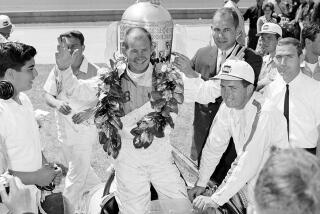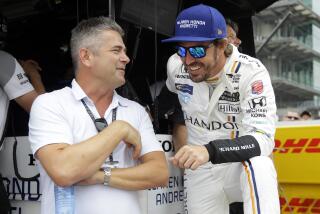Term of Endearment : ‘Ralphie the Racer’ Is a Fixture at a Race He Never Drove
- Share via
INDIANAPOLIS — When an Indiana sportswriter dubbed Ralph Liguori “Ralphie the Racer” several decades ago, it was hardly a compliment.
Liguori, after all, was the answer to a trivia question: Who tried hardest to get in the Indianapolis 500 and never made it?
From 1959 to 1968 he came to the Indianapolis Motor Speedway from Tampa to make the race. He never made it to the starting line. He crashed three times, once in another race before the Speedway opened, knocking himself out of what was probably the best car he ever drove. Once his engine blew just as he was about to finish his refresher course.
Twice he put cars in the field that were bumped.
Ralphie the Racer never let frustration and failure get him down. He kept on racing, turning the derisive nickname around and making it one of endearment.
Last June, at 65, he became the oldest winner in a U.S. Auto Club-sanctioned race when he won a 50-lap midget main event at the Indianapolis Speedrome--a one-fifth mile asphalt oval--in his sixth decade of major league racing.
It moved him past other 60-and-over winning drivers, such as Hershel McGriff, Jim McElreath and Mel Kenyon.
In honor of his victory, Dick Jordan, USAC’s director of communications, presented Liguori a plaque last fall that read:
“Has served as a great ambassador for the United States Auto Club, now competing in the amazing sixth decade of his racing career. Ralph’s legion of followers is nationwide, and his drive for excellence has never diminished. We salute his long-standing membership as a USAC participant and hereby recognize his many contributions to the organization. From his spectacular sprint car triumph in a 1957 race at Langhorne, Pa., to his Indianapolis Speedrome midget victory earlier this season, he has established a USAC record for victory lane longevity. Our hats are off to one of USAC’s finest elder statesmen.”
And it’s not over yet.
“As long as I have my reflexes and my eyesight, and I feel good, I’ll keep racing,” Liguori said recently. “I’ll probably run 15 or 16 races this year. At least, as long as they’ll have me.”
After Liguori retired as an Indy car driver, he continued to return every year simply to be part of the scene. He and his wife, Jane, are in demand at all the social functions surrounding the 500.
“I still love being here, but there have been changes (in racing) that are definitely not all for the good,” he said. “I guess I’m still a little resentful that a poor little rich boy can come back here and buy himself a ride in the 500, and a real good race driver, if he doesn’t have the money, can’t get a ride.
“Can you imagine one of today’s drivers coming here, sleeping all month in his car and showering in the Speedway restroom? That wasn’t unusual when I started out.”
Liguori had been a champion three-meter platform diver at DeWitt Clinton High in New York City with ambitions of making the Olympic team when World War II began and he quit high school to join the Navy. When he returned home, he went to work for his family’s business in the Bronx.
“I was a dress designer,” he said. “I was frustrated. I didn’t want to make a career out of that. I was engaged, and one night during a bad blizzard I was looking in the papers for some place to go and saw a story about a midget auto race at Kings Bridge Armory. It was indoors, and we could get there in the subway, so away we went.
“I decided that night that driving race cars was what I was going to do. I bought a ’37 Ford coupe in a junkyard in Freeport, Long Island, for $25. When I won $25 the first time I raced it, I went home and quit the dress-designing business.”
NASCAR was emerging as a racing sanctioning body about that time, and along with stock cars, it had a series for midget race cars. Most of the races were in the New York area, and Liguori became a NASCAR regular.
“One night, after I’d won $400 in Islip (N.Y.), I heard about all the racing going on in Florida, so I decided to give it a try. We settled in Fayetteville, North Carolina, and I was running both midgets and the big Grand National (now Winston Cup) stock cars.
“Bill France (NASCAR founder) was an incredible visionary, and even though nearly all his stock car drivers and tracks were in the South, he knew the importance of getting other parts of the country involved. One day, I told him I had decided to go back to New York and run open-wheel cars.
“He said, ‘Ralph, you’ve got to stay here. I need a Yankee down here, and I’ve got a guy who will pay you $60 a week and all the money you can make racing. I’m going to advertise you as ‘the Fayetteville Yankee.’
“Well, he was quite a salesman, too, so I stayed.”
Liguori made enough money to buy property in Tampa in 1956, and he and his wife later built the Sunshine Trailer Park. He also worked at Tampa Bay Downs, George Steinbrenner’s track.
“It was perfect for us,” he said. “I would work there in the winter and go racing in the summer. I started driving all sorts of cars in 1956 and decided to take a crack at the 500. Sprint cars were the way to get to Indy back then, and when I won a 100-miler at Langhorne in September, I thought I was ready, but I didn’t get a ride until 1959 in a Maserati.”
For 10 years he chased the dream--still unfulfilled. Liguori’s Indy record:
1959--He passed his driver’s test in the Maserati, the Eldorado Italia Special, the only foreign entry that year. He qualified at a slow speed and was bumped from the field.
1960--He signed to drive one of the Federal Engineering Specials but broke his arm in a spectacular flip at Trenton, N.J., in April.
1961--He was driving the brutish Novi for Andy Granatelli in practice when the engine blew and the car slid in its own oil, slammed into the wall on the backstretch and exploded in flames. Liguori suffered facial burns but returned in time to qualify, only to find that Granatelli had hired another driver.
1962--He practiced in the McKay Special, but it was so slow that he did not try to qualify it.
1963--He qualified the Schulz Fuel Equipment Special at 147.620 m.p.h., but was bumped and named an alternate.
1964--He practiced in the Ollie Prather roadster but made no attempt to qualify.
“I made some bad mistakes,” he said. “I felt that the best way to get recognized was to drive anything I could lay my hands on and show what I could do. The trouble was, I usually got in trouble, got myself a bad reputation and never lived it down.”
1965--He crashed in the third turn during practice, driving the Demler roadster, and never attempted to qualify.
1966--He practiced in Walt Flynn’s rear-engine Ford, but again made no attempt to qualify.
1967--He crashed Flynn’s Ford on a warm-up lap for qualification, breaking a bone in his wrist.
1968--Still considered a rookie, he never finished the four-phase test when the engine blew in the Dayton Steel Wheel car on the first lap of his final phase. Observers praised Liguori for the way he handled the car during the spin, keeping it away from the walls. The next day he got into two other cars but could not get either up to the required speed before time ran out.
“I kept coming back after that, but I didn’t get on the track,” he said. “In fact, I haven’t missed a 500 since I first came here in 1959. Indianapolis is sort of a home away from home for Jane and me. We get an apartment and spend the spring here.”
Liguori had his proudest moment as a racer in the 1970 Hoosier Hundred, a dirt car race in which he passed A.J. Foyt with two laps to go and finished second behind Al Unser. It was his highest Indy car finish in more than 60 races.
Liguori will drive a dirt car in Foyt’s Hulman Hundred, a Silver Crown championship race, on the Friday night before the 500 this year. The race will be on the same Indiana Fairgrounds track where he beat Foyt in 1970.
Looking back on all the frustrations and failures to make the 500, does Ralphie the Racer have any regrets?
“I have only one regret,” he answered. “That I can’t start over and do the same thing. I owe everything to racing.”
More to Read
Go beyond the scoreboard
Get the latest on L.A.'s teams in the daily Sports Report newsletter.
You may occasionally receive promotional content from the Los Angeles Times.










